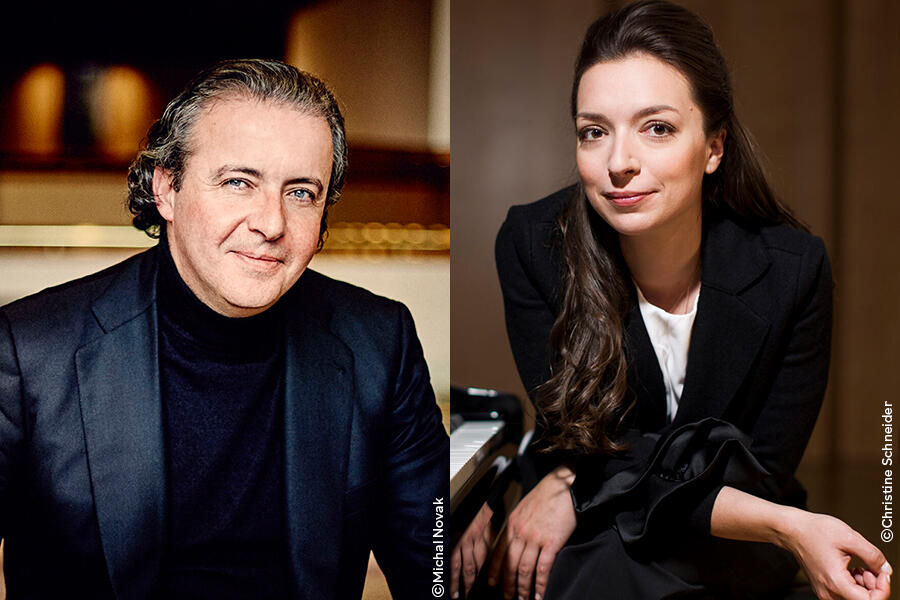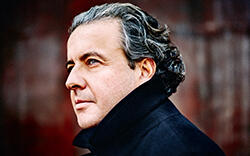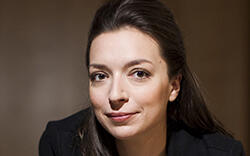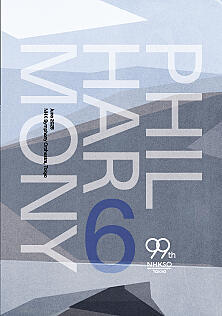- Home
- Concerts
- Subscription Concerts 2024-2025
- Program A
- No. 2039 Subscription (Program A)
No. 2039 Subscription (Program A)

Important Announcement
Program
Rimsky-Korsakov / May Night, opera—Overture
Nikolai Rimsky-Korsakov (1844–1908) is known as a member of The Mighty Handful a.k.a The Five, along with Mussorgsky and others. Formed around 1860, this Saint-Petersburg-based circle of young “Sunday composers” shared an aspiration to develop a nationalist school of Russian classical music inspired by folk elements. One of their stances was being anti-academic: Rimsky-Korsakov at the naval service, however, took a step in the academic world in 1871 becoming a professor of the Saint Petersburg Conservatory where rehearsing the student orchestra improved his already-acute scoring sense. In parallel, his duties as the Inspector of Naval Bands from 1873 deepened his knowledge of wind instruments. His peerlessly masterful orchestration skill will be fully displayed in his later works including Sheherazade (1888).
Composed in 1878–1879, May Night is the second of Rimsky-Korsakov’s fifteen operas. The libretto is after the tale May Night, or the Drowned Maiden by the Ukrainian novelist Nikolai Gogol. Set in a Ukrainian village during the Whitsunday (Pentecost) week, the opera features the Village Mayor, his son Levko and Levko’s girlfriend Hanna, interweaving fantastical scenes with rusalki (rusalka is a water nymph in Slavic folklore).
Utilizing some existent Ukrainian folksongs, Rimsky-Korsakov’s music vividly describes both the rural and supernatural worlds. The eventful overture has, right after its calm introduction, the horn solo crooning the lyrical aria Sleep my beauty, sleep sweetly! (Act III) that Levko sings by a magical moonlit lake.
[Kumiko Nishi]
Rakhmaninov / Rhapsody on a Theme of Paganini, Op. 43**
“What a violin! (...) Heavens! What sufferings, what misery, what tortures in those four strings!” exclaimed the twenty-year-old Franz Liszt (1811–1886) in 1832, after attending a concert of the Italian violinist-composer Nicoló Paganini (1782–1840) for the first time. Paganini’s technical prowess was such that, a rumor widespread that he had traded his soul with Devil for the magical talent. Time passed, and the Russian Romantic composer Sergei Rakhmaninov (1873–1943) enjoyed an extraordinary virtuosity comparable to Paganini, as a pianist. He wrote the Rhapsody on a Theme of Paganini for piano and orchestra in 1934 for himself to play, as one of the few works he created after he left his homeland following the 1917 Bolshevik Revolution.
This piece is composed of a theme and twenty-four variations performed continuously without a pause. Although entitled “Rhapsody” (an episodic, single-movement form), it is designed overall in the traditional concerto format with a rapid movement (1st variation to 10th), a slow movement (11th to 18th) and a rapid final movement (19th to 24th). After a short introduction, Rakhmaninov unconventionally inserts the 1st variation before violins officially present the theme in 2/4 in A minor, a brisk tune from Paganini’s Caprice No. 24 for violin. Pivotal is the sluggish 7th variation in 2/4 in A minor, where the demonic Dies Irae (Day of Wrath) melody from the Catholic Mass for the Dead is first stated by the piano. The very first triple-meter section is the fantastical 11th variation in 3/4 in A minor where the pianist gives a cadenza-like monologue against a background of string tremolos (tremulous effect) and harp glissandos (glides). The 18th variation in D♭ major in 3/4 gives the most romantic, mellifluous melody the composer ever wrote probably, inverting the theme. The piano ensures the theme’s return at the 23rd variation before giving a brief cadenza-like passage without orchestra. The torrential 24th variation resounds the Dies Irae melody in the brass while the piano demonstrates its supreme virtuosity. Rakhmaninov’s last concerto evaporates like a mischievous wink with a fleeting coda.
[Kumiko Nishi]
Tchaikovsky / Symphony No. 6 B Minor Op. 74, Pathétique
The Russian Romantic composer Peter Ilich Tchaikovsky (1840–1893) studied at the Saint Petersburg Conservatory before moving to Moscow in 1866. In his early creative years, he was influenced by the above-mentioned nationalist circle “The Five,” especially its leader Mily Balakirev (1837–1910) whom he met in 1868. Tchaikovsky’s Symphony No. 2 (1872) quoting some Ukrainian folksongs was, for example, warmly welcomed by The Five.
From the mid-1870s, Tchaikovsky’s approach would be diverted from pronounced folkloric colors to a style deeply rooted in the Western, European tradition which was marked by solid classical forms and more subjective expressions, as represented by the Piano Concerto No. 1 (1875), Swan Lake (1876) and Symphony No. 4 (1878). His creative power then withered for some time, but eventually recovered its previous vigor producing The Sleeping Beauty (1889), The Nutcracker (1892) and the Symphony No. 6 Pathétique (1893) to name a few.
Tchaikovsky’s stylistic evolution was, however, brought to a halt by his abrupt death at age 53 in October 1893, merely nine days after he conducted the premiere of the Symphony No. 6 in Saint Petersburg. The cause of his passing is still a mystery, but the commonly accepted theory says he was affected with cholera by drinking unboiled water (some say he committed suicide after some private trouble). The Symphony No. 6, composed in six months in 1893, is well-known for its novelty in form which foretells the composer’s upcoming further adventure in the genre. Although hindered by his demise, this path will be developed by Gustav Mahler in particular.
The French nickname of No. 6, Pathétique, is said to be given by Tchaikovsky himself. Coincidentally or not, the symphony starts with a melody line (E–F♯–G–F♯, on a bassoon) identical to the one (C–D–E♭–D) opening Beethoven’s Piano Sonata No. 8 Pathétique. Moreover, this melody will recur throughout the symphony as a cyclic motif. The first movement’s lugubrious introduction is succeeded by an extended sonata section with two contrastive subjects: the dark first theme given in B minor by violas and the radiant, tuneful second theme introduced in D major by violins and cellos. The graceful second movement is a waltz, a rarity in the symphonic literature, and even rarer is its time 5/4 (2/4+3/4). The third movement alternates a carefree scherzo section in 12/8 with a brassy march section in 4/4. These inner movements, a major-key respite, are followed by the return of the “Pathétique”: the last movement, headed “lamentoso (mournfully),” immediately announces the plaintive falling theme played by the first and second violin sections, trading every note, back and forth. After the heartrending music reaches the zenith, a calm tam-tam strike leads to the slow coda where the symphony dies away in B minor, the complete opposite of conventional triumphant conclusions of symphonies following Beethoven’s spirit of “per aspera ad astra (through hardships to the stars).”
[Kumiko Nishi]
[Encore]
June 7: Tchaikovsky / 18 Pieces Op.72 - No.5 Meditation
June 8: Rachmaninoff /Six moments musicaux Op.16 - No.4 Presto E Minor
Piano: Yulianna Avdeeva
Artists
 ConductorJuanjo Mena*
ConductorJuanjo Mena*
Juanjo Mena is originally from the Basque Country of Spain, where he still lives. The Basque Country has been known as a region of particular ethnicity and culture, but also as the homeland of Ravel (though he was from French side of the region). Partly due to such background, his repertoire was focused on composers of Spain, France and Latin America, including Ravel, however with the development of his career, he expanded his repertoire, and in 2016, he was awarded the Spanish National Music Award, thus advancing as one of the leading maestros to represent Spain. After serving as Artistic Director of Bilbao Symphony Orchestra, Spain (1999–2008), he was appointed Chief Conductor of the BBC Philharmonic of Manchester in 2011 (until 2018), the position of which helped him make his name known internationally, and solidified his reputation not only for his specialism in Spanish music, but also for his symphonic repertoire, including Schubert and Bruckner. He has been repeatedly invited to the world’s famed orchestras for guest-conducting, including the Berliner Philharmoniker.
His first collaboration with the NHK Symphony Orchestra was in 2017, then he returned in 2021, on both occasions, the programs being of Latin and French repertoire. For the coming concert, he has picked Ibert combined with Bruckner, and will exhibit his true value by conducting the expansive Bruckner Symphony No. 6 as he once studied under Celibidache. As he wrapped up the work unstrainedly yet neatly in the recording, we look forward to how the NHK Symphony Orchestra, an orchestra with a long-established tradition for German and Austrian repertoire, will perform the work under his baton.
[Mitsunori Eto, music critic]
 Piano**Yulianna Avdeeva
Piano**Yulianna Avdeeva
Born in 1985 in Moscow, Yulianna Avdeeva learned at the Moscow Gnessin Special School (college) of Music, famous for its early musical education, and from 2003, under Konstantin Scherbakov at the Zurich University of the Arts.
She came to attention after winning the second prize (no 1st place) in the piano section of the Geneva International Music Competition in 2006, and rose to fame in 2010 by winning the International Chopin Piano Competition in Warsaw. Since then, at the forefront as one of the world’s most renowned pianists, she makes her successful appearances in recitals, concerto performances with famed orchestras worldwide, and also in music festivals including the Salzburg and Lucerne. She is also active as a fortepianist. Her performance of focusing on the whole work while delicately polishing the expressions of the details, and incorporating deep emotions, has been highly evaluated.
This is her first appearance with the NHK Symphony Orchestra since 2014. She will perform Rakhmaninov’s Rhapsody on a Theme of Paganini. She will display both the romantic emotion and vivid playing technique of this work in an accurate performance unique to her.
[Motoyuki Teranishi, music critic]
* Artist has been changed from initially scheduled Vladimir Fedoseyev (Conductor).
Download
Ticket
Program A
No. 2039 Subscription (Program A)
NHK Hall
Google Map
Seating Chart
Single Tickets Release Date
Pre-sales for Subscribers:Wednesday, February 26, 2025
*about subscribers
Sale to General Public:Sunday, March 2, 2025
Price
| S | A | B | C | D | E | |
|---|---|---|---|---|---|---|
| Ordinary Ticket | 10,000 | 8,500 | 6,500 | 5,400 | 4,300 | 2,200 |
| Youth Ticket | 5,000 | 4,000 | 3,100 | 2,550 | 1,500 | 1,000 |
Seating chart Enlarge Print PDF
*tax included
*Subscribers receive a 10% discount (Available at NHKSO WEB Ticket and N-Kyo Guide)
*For wheelchair-accessible seats, please refer to the N-Kyo Guide
Youth Tickets
Youth Tickets are great options for those of 29 years old and younger
Subscription tickets
Release Date
ANNUAL SUBSCRIPTION TICKETS
Mon., July 15, 2024 10:00am
[For Subscribers: Sun., July 7, 2024 10:00am]
SEASONAL SUBSCRIPTION TICKETS (SPRING)
Wed., February 19, 2025 10:00am
[For Subscribers: Thu., February 13, 2025 10:00am]
Where to buy
NHKSO WEB Ticket | Saturday, June 7, 2025 (In English / Seats not selectable)
NHKSO WEB Ticket | Sunday, June 8, 2025 (In English / Seats not selectable)
NHKSO WEB Ticket (In Japanese only / Seats selectable)
N-Kyo Guide (Purchase by telephone only)
Other Ticket Agents
Broadcast
 BS Premium 4KNo. 2039 Subscription (Program A)
BS Premium 4KNo. 2039 Subscription (Program A)
Saturday, Jun 7, 2025 6:00PM - 8:00PM
Program:
Rimsky-Korsakov / May Night, opera—Overture
Rakhmaninov / Rhapsody on a Theme of Paganini, Op. 43**
Tchaikovsky / Symphony No. 6 B Minor Op. 74, Pathétique
Conductor:Juanjo Mena*
Piano**:Yulianna Avdeeva
Recorded:June 7, 2025 NHK Hall
*Repertoire, conductor, soloists and program order are subject to change without notice.
*Pre-school children are not allowed in the concert hall


